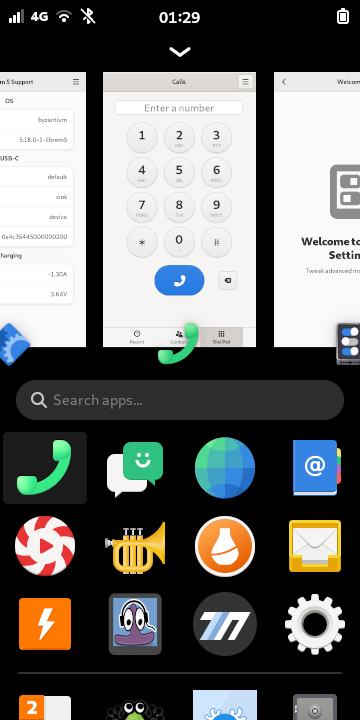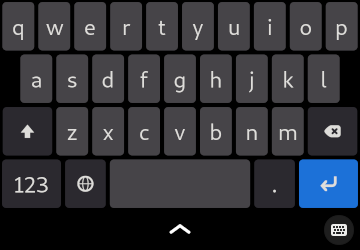Software Tour¶
This guide aims to help you get started with your Librem 5 phone by giving you a quick tour of the phone software.
The first thing you need to do after switching on your phone is to unlock it.
Unlocking the Screen¶
When you power on your phone it will be locked, displaying the lock screen. If the screen has switched off, press the power button briefly to switch it on again.
The screen should now show the lock screen.

The first three icons shows the state of the cellular and wireless networks. If these icons are missing then the switches on the side of the phone have been set to disable the modem and WLAN card.
The fourth icon shows the state of the battery, providing information about its charge level and whether or not it is being charged.
To unlock the screen, swipe up from the bottom of the screen to reveal the passcode entry screen.

Enter your passcode using the numeric keypad. When you have unlocked the screen the phone will display the home screen.
If you have not already entered some basic information about your preferred language, the Initial Setup application will start. When you have completed the setup process, return here.
App Drawer¶
The app drawer is used to access the built-in and installed applications on the phone. It is automatically opened when you switch on the phone and unlock it, giving you the option to launch an app straight away.

The built-in apps are shown in the top row. Installed apps are shown beneath the line. You can launch an app by tapping its icon.
When one or more applications are running, thumbnail images of them will appear in the top half of the screen, above the icons in the app drawer.

Select a running application to switch to it, making it full-screen again. If you want to close a running application, swipe its thumbnail up towards the top of the screen.
Notification Bar¶
At the top of the screen is a notification bar showing the current time, battery level and network status.

This line is also used to access the system settings.
See Notification Bar for a guide to the icons that may appear.
Settings Panel¶
Swipe down the status bar at the top of the screen to open the quick settings panel. This provides access to common settings and notifications.

The two slider controls allow you to change the sound volume and screen brightness.
A series of icons provide shortcuts for common tasks:
The Cellular icon shows the state of the phone’s connection to the cellular network. Tapping this icon opens the appropriate section of the Settings application.
The Wi-Fi icon shows the state of the phone’s connection to any local wireless hotspots.
The Bluetooth icon shows whether Bluetooth is active or disabled.
The power indicator shows the battery’s current charge and charging state. Tapping this opens the Power section of the settings application.
The screen orientation indicator can be used to toggle automatic rotation on or off. Long pressing the indicator allows switching between Portrait and Landscape modes.
The bell indicator is used to enable and disable sound notifications.
The Torch indicator is used to switch the camera flash LED on and off, using it as a flashlight.
The docking indicator shows whether the phone is Docked or Undocked. When docked, the phone can display applications on an external monitor.
The padlock indicator is used to toggle a VPN connection on or off, if you have a VPN connection configured.
To close the settings panel, touch the lower half of the panel and swipe up.
Locking the Screen¶
At the top-left corner of the settings panel is the lock the screen button. At the top-right corner of the settings panel is the power button. Tap this to access menu items that let you lock the screen, restart the phone, and switch off the power.

You can also lock the screen by briefly pressing the power button on the side of the phone.
Notification Area¶
Certain notifications from applications are presented in the area below the settings panel. These are typically notifications that you may have missed and need to be reminded about.

The notifications that appear here will usually be displayed briefly at the top of the screen before they are placed in the area. These include notifications about software updates. It is important to keep up-to-date with updates and fixes to software.
See Notifications for information about how notifications are delivered from applications and the system.
Virtual Keyboard¶
When you need to input text into an application, the virtual keyboard will open automatically. You can also open it manually by pressing the (keyboard) symbol in the bottom-right corner of the screen.
The keyboard provides different views that you can switch between: one with the alphabet, another with digits, and a third view with symbols.
Switch between the views by pressing these special keys:
Press the 123 key to show a view with digits and common symbols.
Press the */= key to show less common symbols.
Press the ABC key to return to the alphabet view for your language.
More specialized keyboard layouts will be shown when certain kinds of input are required by applications. The keyboard handles this automatically.
You can press the (keyboard) symbol to close the keyboard if you need to see more of the screen.
More information about using the keyboard can be found in the Virtual Keyboard guide.
Next Steps¶
The next thing you should do is to change the default passcode. This is described in Changing your Passcode.
After you have done that, you can set up your phone’s connection to the mobile network. This is described in the Cellular Networks section of this guide.


